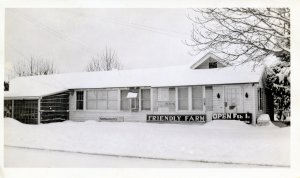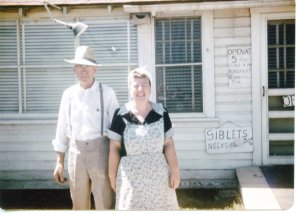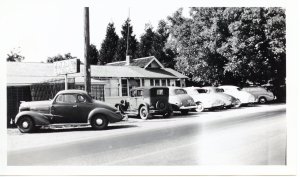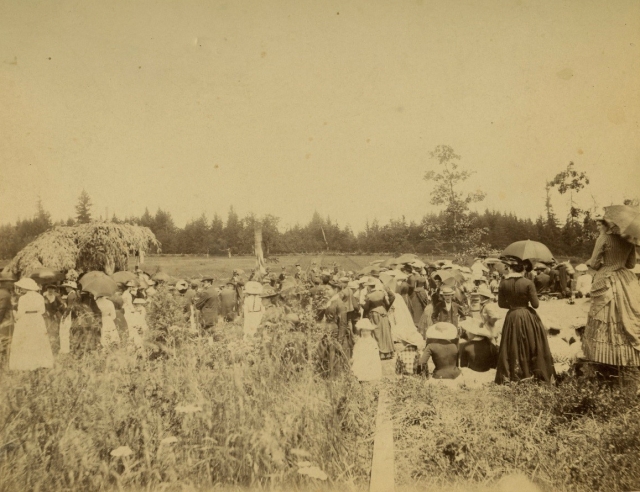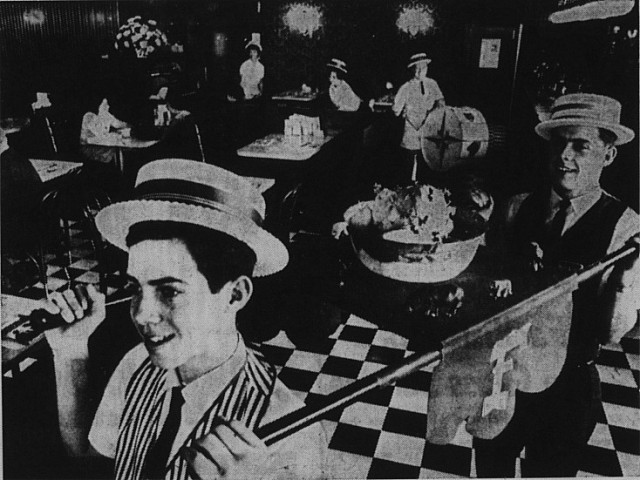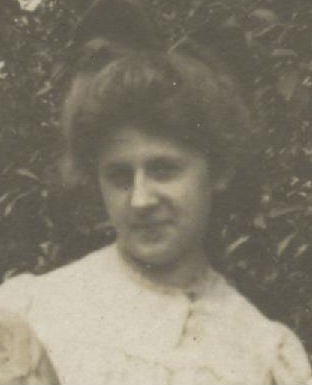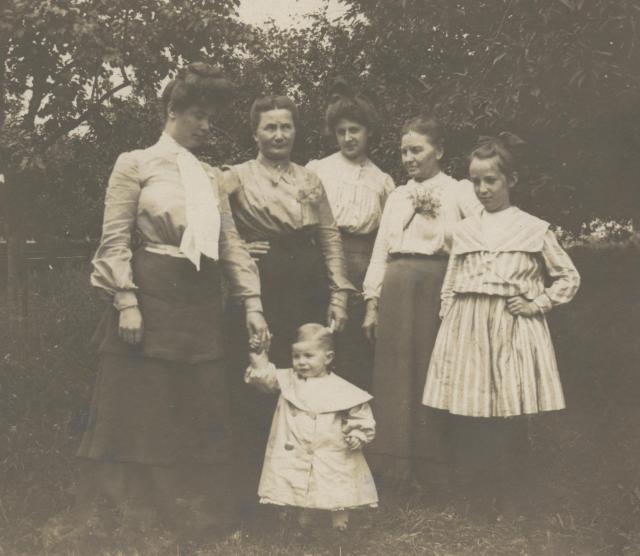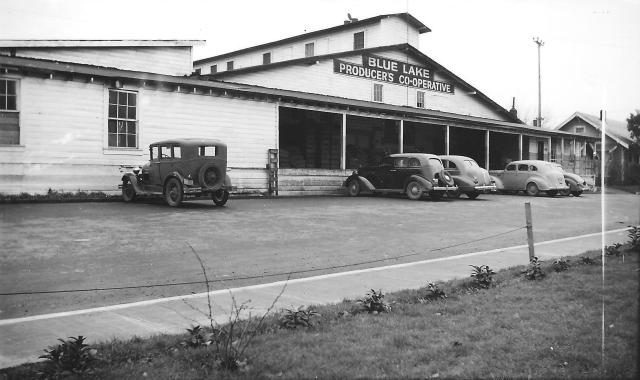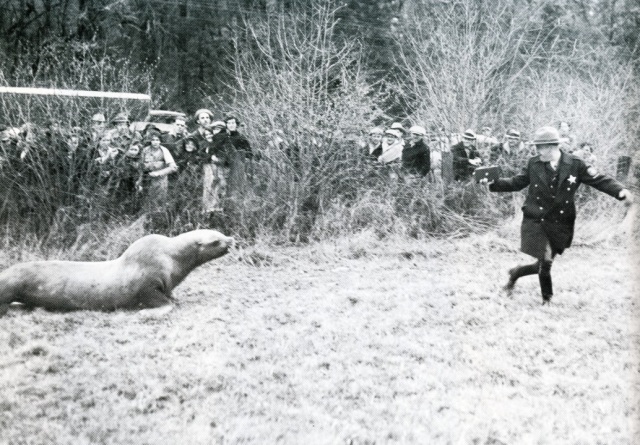This blog is moving! Please visit us at our new site: www.willametteheritage.org/blog.
White’s Restaurant – Maynard Meatloaf Special
reprinted from August 2015 Statesman Journal article
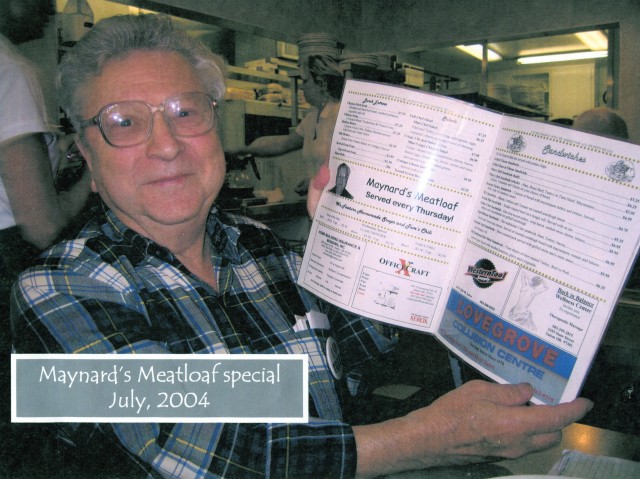
Maynard Drawson holding a White’s Restaurant menu featuring Maynard’s Meatloaf special.
Photo Credit: Willamette Heritage Center 2007.050.0002
White’s Restaurant at 1138 Commercial St. SE is a Salem landmark of restaurant history. Charles and Myrtle White had previously owned White’s Tip Top Lunch in the Hollywood District of Salem during the early 1930s. When they moved their family to South Commercial St. in 1935 they built a new restaurant, White’s Lunch, on the property adjacent to their home. Service and satisfaction were very important to the White’s as stated on the cover of their early menus. Original hours were seventeen a day from 8:00 a.m. to 1:00 a.m. seven days a week. A “plate lunch” special consisted of meat, two vegetables, trim, bread, beverage and dessert for 35 cents.
Ten years later in 1945 son Bob and wife Carole took over the daily management of the restaurant. Plate lunch was still the daily special, though the cost was now 60 cents. Same hours of operation but only six days a week. After World War II Bob’s brother Kenny built White’s Drive-In next door to the original restaurant. It operated from 1948 to 1955 and shared a common preparation area. French fried shrimp on a toasted bun with a side order of French fries was one of the more popular menu items for only 85 cents.
As the years marched on, Bob and Kenny brought their wives and children into the family business. In 1963, a major remodel took place. The original White home adjacent to the property was moved to make room for more parking. The inside of the restaurant was updated to increase seating and modernize the kitchen. The “plate lunch” was replaced on the menu by daily specials for breakfast and lunch. Homemade soups, sandwiches, dinners, salads, and desserts remained popular menu items.
In 1981 Bob decided to retire and put the business in his wife’s name. Carole continued to run the business with sister Judy Haskins and daughter Debbi White Strauch until 1989 when the business was sold. The White family retained ownership of the restaurant building itself. The new owner operated the business until filing for bankruptcy in 1995. At that point Bob and Carole White stepped back into the picture to reclaim the business name. One morning during breakfast in the Ritz Diner over at the corner of State St. and Lancaster Dr. they met Don Uselman. After watching Don cooking the food, talking to his customers and greeting every person that walked through the door Bob told Carol, “I could see that man running my grills.” A friendship was established and after much planning and preparation Don Uselman and his wife re-opened White’s Restaurant in 1996.
One of the more colorful stories behind one of White’s Restaurant specials involves Maynard’s Meatloaf which is served on Thursdays. Maynard Drawson former barber in Salem for 50 years, local radio show personality and founding member of the Oregon Heritage Tree Committee is the man behind the meatloaf, if you will. Here is the story behind the meatloaf special in Maynard’s own words, “I fell out of a tree and damn near died. In fact, I was sick for three to four months. And when I got big enough and good enough to come out, the lady that rescued me…came to lunch with me. And they had meatloaf that day. I said, “You know that meatloaf is pretty good, but it is pretty dry. You know, if you cut some carrots up and blah blah blah.” And the guy that owned the place (Chef Don Uselman) is a friend of mine, and he started writing all of this stuff down and the next thing I know, they put out a new menu, and there is Maynard’s Meatloaf.”
What makes Maynard’s Meatloaf so special? The secret ingredient, carrots. And just in case you were curious, here’s the recipe from the Maynard Drawson collection currently held at the Willamette Heritage Center.
Maynard’s Meat Loaf
- 2 lbs. ground beef
- ¼ cup bread crumbs
- 2 Tbs. basil
- 1 can tomato paste (6 oz.)
- 1 Tbs. minced garlic
- ½ c. fine shredded carrots
- 3 eggs
- 1 Tbs. taco seasoning
- 1 Tbs. oregano
- 1 cup diced onion
- 2 Tbs. Worcester sauce
- Salt and pepper to taste
Mix all ingredients together in a KitchenAid mixer at #3 for 3 minutes using the flat mixer attachment. This will give you all the sinew and gristle mixed up on the mixer attachment. Throw away this part as it will make your meatloaf much more enjoyable to eat. Put remaining mixture into a loaf pan and push down by hand. After packing the loaf pan, bang the pan on a solid surface to pack. Bake in a preheated oven (325 degrees) for 90 minutes until meat thermometer reads 160 degrees.
Friendly Farm Restaurant – Jim & Marguerite Sumpter
This article was written for the Statesman Journal and published July 2015. It is reproduced here for reference purposes.
The Daily Capital Journal newspaper dated November 5, 1938 stated it perfectly. “Some people have a way of always making you feel welcome. That’s the spirit that’s in the air at Friendly Farm. A place for the traveler to stop and get real home-cooked food, and a mecca for the townspeople to supply their tables with fresh fruits, flowers, and vegetables in season. Listen closely now – we have a surprise for you. Marguerite Sumpter has finally decided to serve her public that scrumptious fried chicken – cooked and seasoned exactly like mother made.”
Friendly Farm restaurant at 4645 Portland Rd. attracted families in the Salem area for over 30 years. Marguerite and Jim Sumpter started off with a fruit stand, selling produce from the family farm where Marguerite had lived since she was ten years old. Customers soon demanded light lunches, so the couple began serving sandwiches in a small building Jim built on the property which seated seven customers. Several years and additions to the building later, Friendly Farm became a full-fledged restaurant known for Marguerite’s special recipe fried chicken, potato salad, hot biscuits, and fresh, home-made pies.
The Sumpters made a great team. Jim was headwaiter, bottle washer, and soda jerk when needed while Marguerite ran the kitchen and mothered the local girls they employed as waitresses. Jane Kerber, one of their girls, wrote many years later that Marguerite was the real boss at Friendly Farm, but both she and Jim were more like parents to all the girls that worked for them. Jane also recalled. “We would get so busy – especially on Sundays. Marguerite would be frying the chicken and French fries or mixing up another batch of her special potato salad all while talking to the customers, laughing and joking. When it got too hectic Jim would say ‘And this too shall pass away!’ And Marguerite would say, ‘Now Jim, its O.K.’” The restaurant’s busiest day on record was Mother’s Day, 1957 when the restaurant served 450 dinners.
Friendly Farm kept seasonal hours, open from February to December. The Sumpters enjoyed their winter break, often traveling to sunny, warmer climates around the world. During their travels Marguerite would write cheery newsletters to longtime restaurant customers, employees and neighbors with the details of their trips. She was also a faithful correspondent to many former employees and customers serving in the military during World War II and the Korean War. One particular correspondent was Harold L. Hill, a graduate of Salem High School who served 3 ½ years in the Navy during World War II. Her letters pulled him through a few rough patches in the South Pacific, including homesickness and a hospital stay. His letters, which Marguerite saved give us a glimpse of the food, atmosphere and warmth found at Friendly Farm restaurant. In one letter dated April 11, 1944, he asked Marguerite to play “I Ain’t Got Nobody “ on the juke box to remember him by, promising after the war to “park myself in my favorite booth and eat chicken till I haven’t got any room left except for two or three helpings of potato salad.” Harold kept that promise in 1946, the year he returned safely from war and married his sweetheart, LaVile Czarnetzki.
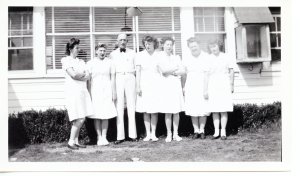
Jim and Marguerite Sumpter standing in front of Friendly Farm Restaurant with some of their waitresses circa 1940s. WHC X2012.018.0112.002
Little did Jim and Marguerite Sumpter know when they first opened up a fruit stand in the 1930s the impact they would have. One of their former neighbor girls Myrna Landon McHugo wrote in 1967, “As I grow older with my husband at war and life sometimes very sad…I often think of the summer spent with you at Friendly Farm laughing, smelling the heavenly smells and am comforted by the love of two wonderful people who gave me so much happiness.”
After Jim Sumpter passed away in December of 1969, Marguerite decided to retire and closed the restaurant the following year.
Odd Fellows Rural Cemetery
This article was written for the Statesman Journal and published May 2015. It is reproduced here for reference purposes.
“Cover them over with beautiful flowers,
Deck them with garlands, those brothers of ours,
Lying so silent by night and by day
Sleeping the years of their manhood away.”
-Will Carleton
In 1854, Chemeketa Lodge No. 1 of the Independent Order of Odd Fellows, in partnership with the Masonic Lodge, purchased a five acre tract of land in rural Salem for a cemetery. Acquired from Reverend David Leslie and his wife Adelia Judson Leslie, the land encompassed the original family burial ground and was laid out on a gently ascending slope set back from the west side of the Territorial Road, a mile and a half from the Salem town center. The earliest grave memorialized is that of Mary Kinney Leslie, the first wife of Reverend Leslie, who died in 1841.
In keeping with the basic tenets of their brotherhood, the I.O.O.F. “visit the sick, relieve the distressed, bury the dead and educate the orphan.” In Salem, that mission to bury the dead was realized in the purchase and development of the Odd Fellows Cemetery. Historic records show that all lots in the original 5 acre plat of the cemetery, comprising sixteen grave spaces, were sold by the Lodge at an average price of $20.00 per lot, or $1.25 per grave. The founders excluded no one from their sale of lots. Burial records and newspaper notices document 43 African-American men, women, and children buried in the cemetery. In the northern margin of the cemetery, in a sparsely marked field, Marion County held “paupers plots” for the burial of orphans, indigents, vagrants, and inmates of public institutions. Also within the northern margin was a little square or plat reserved for the Chinese of Salem for temporary burials in accordance with their custom of recovering the bones of the dead to be returned to their homeland after a number of years. Several Japanese-American families occupy burial spaces in five adjoining plots located in the northeast corner of the cemetery.
The cemetery is also the final resting place of 286 veterans of United States military service, the greatest number of them Civil War veterans. Odd Fellows Rural Cemetery became the city’s first focal point for observances of the national day of remembrance that had been proclaimed by General John A. Logan, commander of the Grand Army of the Republic, in 1868 for fallen Union soldiers of the Civil War. In time, Decoration, or Memorial Day, May 30, came to honor all the nation’s war dead. The Daily Statesman, June 1, 1884, described the procession which formed at the town center before making its way south on Commercial Street. A detailed account was given of the proceedings, including prayers and addresses by Grand Army of the Republic Post officers and chaplain, musical selections from band and chorus, and scattering of flowers upon a symbolic grave.
“Memorial Day was observed in Salem Friday with the usual parade and splendor. Promptly at the hour of one o’clock, the various societies assembled in their respective halls, and, after due preparation, began to assemble upon the streets. By the hour of two the column was formed on Commercial Street, in front of Marion Square, in the following order:
- Band,
- Capital Guards,
- Fire Department,
- I.O.O.F. Lodges,
- A.O.U.W. Lodge (Ancient Order of United Workmen),
- Knights of Pythias,
- Sedgwick Post No. 10, G.A.R.,
- Thirteen girls in Liberty car,
- Ladies Relief Corps in carriages,
- State, County, and City officers,
- Citizens in carriages,
The procession then moved promptly up Commercial Street to the I.O.O.F. Cemetery, where the exercises were held.”
The photograph accompanying this article is dated 1885 and is believed to be one of the earliest dated photos of a Memorial Day observance in Salem. The crowd is facing away from the photographer, with the exception of seven men at the back dressed in Civil War uniforms. The photograph is labeled with the name Ethel Veatch Timmerman. Ethel is the daughter of James Pinckney Veatch and Alcinda E. Lawrence, pioneers of 1863. The Veatch family purchased plot no. 722 of Odd Fellows Cemetery in the year 1880 following the tragic deaths of two daughters; baby Minnie Myrtle on February 23, 1880 and their eldest daughter, sixteen year old Jeannette May on April 11, 1880 following an eight week illness. It would not be far-fetched to assume that the photograph represents the family attendance at the Memorial Day observance in 1885.
In future years Odd Fellows Cemetery would expand to a total of 17.05 acres, city growth boundaries would grow to encompass it, the name would change to Salem Pioneer and ownership would be deeded over to the City of Salem.
A Sense of Place: Halls Ferry
This article was written for the Statesman Journal and published April 2015. It is reproduced here for reference purposes.
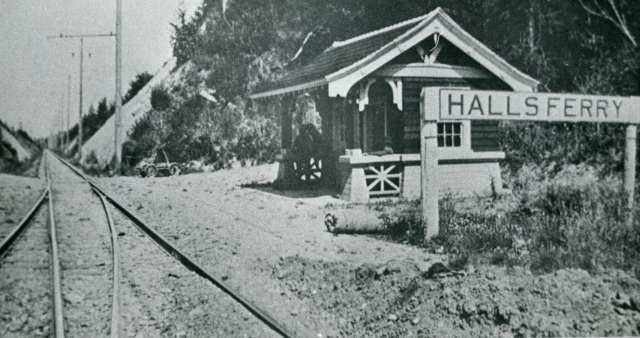
Rail station at Hall’s Ferry in 1915. It provided a connection between the Oregon Electric Railway and the ferry. A small incline vehicle on rails took passengers from track level to river level. WHC 2007.001.0398
“We recently bought a piece of property out River Rd. past the island, but before the first railroad overpass,” so their story began. The couple that walked through the Research Library doors began their archival quest like so many others had before them with a piece of property or a family story that they wanted to know more about. In this case, the couple sought a “sense of place”, a connection to their newly adopted city and state, the land on which they walked and the home in which they lived. They had recently moved from out-of-state, bought an older home with property, and from the number of neighbors and passers-by with stories to share, suspected there might be something more.
One passerby shared a story about a dance hall that had been built on the property and the people that would ride the Oregon Electric Railway out for the dances held on Saturday nights. A neighbor confided that the home the couple had bought used to be a schoolhouse. And yet another had stopped by with the story of yearly rodeos held on the property. Exciting to be sure, but true? “Where do we begin?” they wanted to know.
We started by pinpointing their property on a current map, looking particularly for the township, range, and section coordinates. Using this standardized grid system developed by the U.S. Government’s General Land Office (now Bureau of Land Management) back in the early 1800s would allow us to easily trace the property’s location through time and across a variety of maps including the Marion County Geographic Information System (GIS) database available online through the Marion County Assessor’s Office.
Then we moved to a series of Metsker maps from the 1920s, 1940s, and 1970s available in our library. This allowed us to step our way back through time, physically tracking how the property ownership changed. We also consulted the free online Metsker maps at HistoricMapWorks.com to help fill in the gaps. Unlike many of the map publishers of the time who limited themselves to publishing maps of more developed areas, the Metsker family excelled at recording the history of the then rural and wilderness geographies. This makes them invaluable for tracing land ownership of undeveloped areas and how it changed over time, particularly for our researchers.
We discovered that the property the couple had purchased was in Halls Ferry, approximately 9 miles south of Salem, on the eastern shore of the Willamette River. The area was named for a ferry operated by Benjamin Franklin Hall from 1884-1902 and in its heyday boasted a store, post office, school, cemetery and railway station. The area was primarily agricultural and boasted bumper crops of hops, loganberries, apples and onions. A school location was identified on two of the Metsker maps, without further identifying details such as proper name or specific location on the property which was originally owned by the Riverview Land Company. No clues of a dance hall or rodeo grounds appeared on the maps.
We definitely needed to fill in some informational gaps, starting with the school. A quick glance at the book Early Schools of Marion County provided a few more clues and a rudimentary, unscaled map with school locations in that area. Halls Ferry School seemed the most likely, but the book included no address or identifying years of operation. Next step, a visit to the Oregon State Archives web page to check their historical records inventory for available Marion County school records pertaining to Halls Ferry School. Still not the level of detail that we were looking for in order to tie the home-owner’s property to the school location.
So where to fill in the information gaps? How to better gain a sense of place beyond land descriptions and names on paper? Newspapers, of course. We started with the Historic Oregon Newspaper Project online, searching with the name “Halls Ferry School” and noticed that many of the search results were found in a section of the Capitol Journal newspaper titled “Willamette Happenings.” Within this section of the paper were posted folksy letters written by community correspondents throughout the Willamette Valley. Published once a week in the Saturday edition of the paper, you might find news about your city or community in Marion County. This proved to be a goldmine, especially once we switched to the Library of Congress website, Chronicling America: Historic American Newspapers and found successive issues of the Capitol Journal (1888-1980) available to give us weekly news updates of the Halls Ferry community we were interested in.
Here we found the minutiae, what might seem to be trivial details of the people coming and going, roads being built, births and deaths, bumper crops, crime reports, etc. Trivial unless it’s your ancestor, or in this case, property owner. In the February 23, 1917 issue of the Capitol Journal newspaper we found “the people of Halls Ferry…enthusiastically congratulating themselves in having attained a school. It was sorely needed as many children in the immediate vicinity have long been deprived of the necessary schooling which each and every child is rightly entitled to.” Further articles listed special school meetings electing directors, issuing thank-you votes to Mr. Croisan and the Riverview Land Company who donated the land for the school, surveyors, bond measures, and so forth. One of the more interesting details picked up in the March 26, 1917 edition was a description of the land as being “just east of Halls Ferry station, about thirty rods… (with) a fine grove of oak maple and fir timber on the tract.” This perfectly matched both the property owner’s description and our map research.
The rail station at Hall’s Ferry as seen in the picture circa 1915, was a unique design that had not previously been used in Oregon. Halls Ferry station was the connection between the Oregon Electric Railway and the small motor launch that took passengers via the river to Independence, Oregon. A small incline vehicle on rails took passengers from track level to river level.
What about the dance hall? In the March 2, 1917 issue of the Capitol Journal we read that “E.B. Smith and co-proprietors of “Veita Springs” have arranged to make extensive improvements within the next few months, one of which will be a large dancing pavilion, concrete floor 50 x 80 feet, and the building of a number of cottages for those wishing to camp and for week end visitors; also making a fine parking place for automobiles.” Another clue to follow-up on. And the rodeo grounds? That is still a mystery in progress.
It is often a combination of characteristics that make a place special and unique. With a sense of place we feel welcome and connected to our property, our neighbors, the community, particularly as we become familiar with not only its physical features, but the knowledge and folklore related to it. As Kent Rydon so eloquently wrote, “a sense of place results gradually and unconsciously from inhabiting a landscape over time, becoming familiar with its physical properties, accruing history within its confines.”
Carolyn B. Shelton, Oregon’s First Woman Governor (for a weekend)
This article was written for the Statesman Journal and published February 2015. It is reproduced here for reference purposes.
“Oregon Has Today a Woman Governor” the headlines of the Daily Capital Journal (Salem, OR) trumpeted on February 27, 1909 with the subheading of “Mrs. C. B. Shelton First Woman to Govern Any State”. This amazing twist of historical fate was set in motion with the election of then-governor George E. Chamberlain to the U.S. Senate. Freshman senators were slated to be sworn in March 4th in Washington D.C. If Chamberlain stayed through the end of his term on March 1st and then traveled, he’d be sworn in late, meaning that every other member of the freshman senate class would have seniority over him. This would not do. Now ordinarily, this could have been neatly arranged by having his successor Frank W. Benson come in early as “acting governor” but Benson was too sick to do this. So on February 27th when Governor Chamberlain officially resigned and climbed aboard the train headed for the East Coast, he handed over the power of the governor’s office to his private secretary Carolyn B. Shelton. At least for the weekend, she became the first woman governor of the state of Oregon, ironically three years before women officially won the right to vote in the state.
Something important to note. At the time Mrs. Shelton became “acting governor” the state law read that in the event of the chief executive’s death the Secretary of State should become governor. It was the custom that in the absence of the governor, whether illness, travel out of state, and so forth, his private secretary should become acting head of state.
The twist of fate in this story hinged upon the fact that prior to Governor Chamberlain’s administration, private secretaries had been male.
I stumbled across this fascinating story while looking through a set of Guiss family photographs in the collection of the Willamette Heritage Center. The photographs were labeled with Guiss family names except for one, the name Carolyn Shelton. Who, I wondered, was Carolyn Shelton? I traced the Guiss family from a drug store in Woodburn to Patton Brothers Store in Salem. Leah Guiss, daughter of the drug store Guiss’ married Edwin Cooke Patton and it is because of this union that we find a connection to Carolyn. According to the 1905 Marion County census, Mrs. Shelton boarded with the Patton family. The timing of this is concurrent with her service to Governor Chamberlain in Salem.
Further digging into the U.S. Federal Census records and city directories provided a neat framework for Carolyn Shelton’s life but it was not until I accessed the Historic Oregon Newspapers Project and Historical Oregonian databases that the full story came to light. The newspapers allowed a peek into her childhood in Union County, Oregon, her work history, and eventually her unique role in the history of Oregon. Sadly with the exception of a rather grainy picture in the Oregonian dated February 13, 1909, the two photographs from the Willamette Heritage Center are the only ones I’ve been able to discover. So who was Carolyn B. Shelton, Oregon’s first woman governor?
Carolyn B. Skiff was born in the month of October, 1876 to Willis S. & Mary C. Skiff of Union County, Oregon. Her father made history himself in Union County when he mysteriously disappeared on the night of July 24, 1886 while waiting for a midnight train to take him home. Because of Skiff’s prominence in the community, the Pinkerton detective agency was called in and huge sums were spent in tracing down every clue, but to no avail. Carolyn’s mother died two years later leaving her orphaned children, Nolan, Carolyn, and Mabel, in the care of their older brother Orrin and his wife Elizabeth. This was not a happy situation and a year later local attorney J. W. Shelton was appointed guardian for the trio.
On October 27, 1892 at the age of 16, Carolyn married John W. Shelton across the border in Weiser, Idaho. Both the bride and groom were from Union, Oregon. The couple moved to Portland shortly after. Tragically, two years later and just a month before her 18th birthday Carolyn would find herself a widow. After John’s death she obtained a job as a stenographer at the law firm of Starr, Thomas and Chamberlain. This was her first introduction to George E. Chamberlain, an up and coming attorney, politician and future governor of Oregon.
She began her business career working in his law office as a stenographer where it quickly became apparent that she had a natural aptitude for the more technical terms of the law. This ability led to the opportunity to draw up many of the legal papers prepared in the office, work usually entrusted to a young lawyer. When Mr. Chamberlain was elected District of Attorney for Multnomah County and later Governor of Oregon she went with him as his private secretary and assisted at innumerable state and social affairs in Salem including the 1903 visit of U.S. President Theodore Roosevelt.
A newspaper article from the time period described her as a “tall, slender woman, with dark eyes and hair, a woman with a charming manner, and behind it all a subtle personality.” She faithfully served under oath of office as Governor Chamberlain’s private secretary until that fateful day in Oregon history that she found herself “acting governor” for the weekend. Then Mrs. Carolyn B. Shelton packed her own bags for Washington D.C. to continue her work as Chamberlain’s private secretary in addition to clerking for the senate committees that he served on. This working partnership continued for 30 years until the death Chamberlain’s wife in 1925.
In February of 1926, George Chamberlain suffered a paralytic stroke which left him an invalid and on July 12th of the same year he married his longtime secretary Carolyn B. Shelton in Norfolk, Virginia. It came as no surprise to his friends or family. Sadly, their marriage only lasted for 2 years before he passed away from causes incident to the stroke he had suffered. After his death, Carolyn returned to her childhood home in Union, Oregon to live. She made frequent visits to friends in Portland and Salem, including the Guiss and Patton families. On February 3, 1936, Mrs. Carolyn Shelton Chamberlain passed away after a sudden illness, while in Salem. After a memorial service at Rigdon’s Chapel, her body was sent back east to be buried in Arlington National Cemetery with her husband George Chamberlain and his first wife. A fitting end for a woman who dedicated her life to public service both in her home state of Oregon and later to her country.
Jack and the Bean Stalk – the Hollywood connection to a West Salem cannery
This article was written for the Statesman Journal and published January 2015. It is reproduced here for reference purposes.
All because a great American comedian, Lou Costello, saw promotion possibilities where the publicity directors of Warner Bros. studios didn’t, a Salem industry and the city of Salem itself became national news. It was a fairytale dream come true for the owners of the Blue Lake Packers, a cannery whose humble origins began during the Great Depression with a small group of farmers. The group possessed little or no physical assets or finances, but under the vision of Oka E. Snider, a fellow farmer, the group formed the West Stayton Packing Company to grow beans to be processed at the Cleary-Hillman Packing Company which was located at 325 Patterson Ave. in West Salem. The group was quality conscious from the beginning and with the cooperation of several seed companies they became the first co-op and cannery to grow and pack “100% Stringless Blue Lake Beans.” Later beets, corn, carrots, berries and cherries were added to the list production line. Pulling themselves up by their bootstraps, the farmer’s cooperative retained control of their product by marketing on a percentage basis, keeping control of sales and the selling price. Within two years they purchased one-half of the common stock at the Cleary-Hillman Company and began setting up their own direct selling connections, then on May 25, 1938 they purchased the remaining company stock and took over the cannery, changing the name to “Blue Lake Producers, Cooperative.” They suffered a devastating setback on December 31, 1944, when the cannery burned to the ground during the height of the war effort, but re-built within the year; a tough feat with wartime shortages. In 1946, they changed their name to Blue Lake Packers, Inc. By 1952, twenty years from their initial partnership, the Blue Lake Packers board of directors decided it was time to celebrate. At their annual meeting in February of that year they designated 1952 the Jack and the Beanstalk year after their most profitable label line and decided to pursue national advertising. Little did they know that Lou Costello and Warner Bros. Studio were working on their own Jack and the Beanstalk project and would soon come calling. Paul Colwell, the Blue Lake broker for the Los Angeles area was the first to see the possibilities. He heard that Warner Bros. Studio was filming the comedy team of Abbott and Costello in a picture titled “Jack in the Bean Stalk.” Colwell pitched them an idea, why not tie-in Jack and the Beanstalk green beans? The studio was interested, but wanted a staggering price from the cannery to be involved. Colwell joked at the time that the studio not only wanted the packing company, but a congressional appropriation to boot in order to enter into the deal with Blue Lake. He walked away from the meeting and promptly forgot about it. A few months later the studio called him. Why hadn’t he been back? C’mon down they said, we’re ready to make a deal. Colwell went to the meeting. Lou Costello was there and what he had to say caused M. W. Merrill, sales manager for the packing company to fly from Salem to L.A. and they both listened to the comedian – who wasn’t being funny, just sensible. Costello had a whale of an idea. When Lou Costello learned that Jack and the Beanstalk was the name of a brand of green beans, he got such a kick out of the idea that he went to bat for the tie-in deal. But what will it cost? Colwell and Merrill wanted to know, wary after the first studio proposal. Said Costello, “Listen. It won’t cost you anything. This tie-in, with the Jack and the Beanstalk label in grocery stores and eating spots all over the country will help the picture more than the picture will help you boys.” Merrill made a unique merchandising deal with Costello and Warner Bros. Studio. As a result the cannery label appeared prominently all over the country where Blue Lake Packers’ canned goods were distributed. Special posters were made up for display in grocery stores and theaters, special merchandising displays of green bean cans were placed in theaters showing the Hollywood version of the famous tale, including the Capitol Theater in Salem. Abbott and Costello made personal appearances in a lot of newly-opening markets where Jack and the Beanstalk beans were being featured. Lou Costello personally spent more than $1000 in air express charges sending cases of Blue Lake Jack and the Beanstalk beans to 43 nationally-known radio commentators and journalist friends throughout the nation. And do you remember the giant’s breakfast in the famous tale, all the eggs that Jack had to fry for him? Well, courtesy of the National Poultry and Egg Board, 50 million Blue Lake labels went all over the nation on exactly that many cartons of eggs featuring the giant’s breakfast. For the Blue Lake Packers it was a fairytale ending to their 20th anniversary year, never to be forgotten thanks to a quality product with a label that caught the eye and tickled the funny bone of a famous comedian.
Christmas Flood Evacuation of Salem Memorial Hospital – December 1964
This article was written for the Statesman Journal and published December 2014. It is reproduced here for reference purposes.
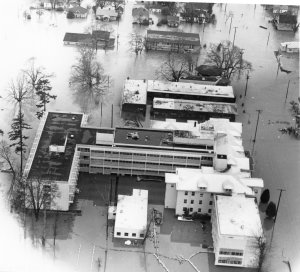
Salem Memorial Hospital surrounded by flood water after Pringle Creek breached its banks. WHC 2012.49.124
Monday December 21, 1964, Salem residents watched anxiously as the Willamette River began to rise at the rate of 3 inches per hour following a rainstorm the National Weather Service in Portland dubbed, “the most severe rainstorm to ever occur over western Oregon since the late 1870s.” The Pineapple Express storm had brought persistent heavy warm rain over the top of snow still left on the ground from the previous week. Basements in the city, including that of Salem Memorial Hospital, were flooding and storm drains were clogged with chunks of ice and snow. Shelton Ditch and Mill Creek overflowed their banks and control dams were working at full capacity. By Tuesday, Pringle Creek threatened to breach the dike around the hospital. Oregon Correctional Institution inmates, Regional Parks Department employees and hospital staff placed sandbags at the north and south sides. The inmates continued to work throughout the night pumping and sandbagging until the creek overflowed and water rushed in creating a lake around the hospital and filling the basement with 7 feet of water. At 7:30 a.m. Wednesday morning, December 23rd, the decision was made to evacuate the hospital’s patients based on a number of factors including: loss of power, threat of fire and health hazards to patients, no means to care for patients without the basement services, and no way to bring patients in or take them out. Patients would be taken to Salem General Hospital located on Center St. near the State Hospital. Ambulances from the State Hospital, Red Cross and Willamette Ambulance Service were called in to help, as well as military vehicles and private station wagons. The vehicles were brought down Oak St. as close to the hospital as possible while remaining on dry ground. Within a span of two hours all 121 patients were evacuated through hip-deep water by National Guardsmen, doctors, firemen, Memorial and State Hospital personnel and others. About 80 patients were taken to Salem General Hospital but only 66 were admitted, the rest were discharged.
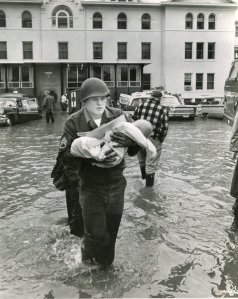
Staff Sergeant Larry Penrod carries newborn baby Garcia along with bottles, records and medication to safety during the evacuation of Salem Memorial Hospital December 23, 1964. WHC 1998.010.0050
National Guardsmen resembled proud fathers as they carried 9 newborn babies in their arms to emergency vehicles, including two infants born three hours prior to the evacuation. One premature baby was removed in an incubator. Their mothers were carried out on stretchers. “Our little babies all went out in red socks,” said Mrs. Fae Lefor, supervisor of nursing who assisted in heading the evacuation. “And I heard only one of them cry,” added another hospital employee. Staff Sergeant Larry A. Penrod of Troop C, 1st Squadron, 82nd Cavalry division of the National Guard was one of the “proud fathers” as seen in the accompanying photo. A 23-year-old father himself, he is pictured carrying two-day-old baby girl Garcia in his arms along with bottles, records, and medication. When interviewed in later years, he said he “was eager to do anything that could help” and that it “was a natural high to help somebody out who was in need. It was fun – in a strange sort of way.” Mrs. Vicki Sanders got to hold her 12-hour-old daughter Yvette for the first time while she sat on a makeshift plank bench in the rear of a National Guard truck. Vicki and her baby were carried separately through the hip-deep water to the truck, which delivered them to the home of Vicki’s mother. Only the day before, at 7:31 p.m. Vicki had given birth to Yvette. She later recalled that Pringle Creek was running across the street on Dec. 22nd, the day she went into the hospital. “I didn’t know much about the flood going on outside,” Vicky said. “I was having my own painful experience.” She said the National Guard troops and others who helped in the evacuation were “extremely well organized, but frantic. There wasn’t much time for TLC like teaching me how to take care of a baby.” Back at the hospital, Bob. L. Brooks, the hospital pharmacy operator, remained to shuttle drugs to Salem General Hospital when needed. Hospital officials then began a systematic check of the building, setting up priorities for removal of records and other equipment in case the waters continued to rise. Remaining on duty at the switchboard in the darkened hospital were Dottie Duval and Lou Davis. Many persons called the hospital after the evacuation for information and admittance. The telephone attendants had a difficult time convincing some that the hospital was closed and evacuated. Three days later on Saturday, December 26, 1964, a flood of governmental and private agencies, along with many volunteers, turned Salem Memorial Hospital into a beehive of activity in an attempt to get the flood-closed hospital back into operation. The hospital’s basement was pumped free of water and Chemawa Indian students manned shovels and brooms to clean up debris and mud. The State Prison and Correctional Institution rewired damaged motors and other electrical equipment. Pumps, fire trucks, bulldozers, and graders were pressed into service. By Monday afternoon the hospital was back in operation, though laundry and food service had been contracted to outside firms. Many of the patients evacuated remained at Salem General Hospital until their recovery. The only patients expected back were those under long recuperation orders. The Christmas Flood of 1964 was inarguably the largest flood to occur since major dam construction on the upper Willamette River and now, 50 years later it is still referred to as the “flood by which all other state disasters were measured.” It brought out the bravest and best in our community.
Farley E. Mogan – The Oregon State Policeman and the Sea Lion
This article was written for the Statesman Journal and published November 2014. It is reproduced here for reference purposes.
The call came over the radio to state police patrolman Farley Mogan shortly after sunrise Feb. 25, 1936. A sea lion had been found lumbering clumsily across rain-soaked grain fields two miles north of Aurora, a mile and a half from the Pudding River. She’d flattened three fences before finally coming to rest on the Erickson ranch – wounded and belligerent. Officer Mogan was first on the scene followed shortly after by Jim Evans, a telephone company “trouble shooter” out of Aurora. Together the men led the angry animal a quarter of a mile to the Aurora-Wilsonville road over the Marion county line. The procedure was simplicity itself. Alternately offering themselves as objects for assault, they teased the short-tempered sea lion into a series of charges that brought her, at length, to the fence beside the highway. They were tired, and so was the animal, when the chase ended.
Word of the spectacle spread like prairie fire through surrounding towns and school principals sent more than 25 bus loads of students to the pasture to see the sea lion. Later estimates by the state police reported 5000 people during the three hour period in which the large animal was roped and loaded. No spectators were allowed past the shoulder of the road into the pasture because of the imminent danger of a charge.
Shortly after 10 A.M. F.O. Haldeman, state game department representative, and Sergeant Everett Meads of the state police department arrived with a big United States geodetic survey truck. Ropes and tackle were arranged while the exhausted animal lay with folded flippers on the wet ground. When the noose first settled on her heavy shoulders the sea lion gave a rumbling, coughing roar and charged at her tormentors. The six men on each of the two lead ropes managed to stop her even though they were dragged several feet each time. More ropes were applied and for perhaps a dozen feet she was in turn driven and goaded towards the truck.
With a bellow, she changed her mind. Whiskered muzzle pointed skyward, heavy shoulders humped, she surged free of the tackle and the ropes slid off her body and charged the crowd of spectators. Farley Mogan of the state police and patrolman Mayfield of the Oregon City police department barely missed a mauling as they distracted her from the crowd and offered themselves as targets. The second attempt with rope and tackle proved successful. She was securely trussed and her nine foot body hauled toward the truck. Rumbling, threatening and lashing out with her “terribly fanged jaws” she protested every inch of the way, but the officers succeeded.
The driver of the truck was given instructions to stop at every sizeable city on the way to Lincoln City to allow spectators to see the strange captive and to hose down the big animal with service station hoses. She was liberated shortly after 6 p.m. on the beach at Nelscott, only a short distance from the rookeries.
This would not be the first time in the history of the Oregon State Police that the troopers found themselves on animal duty, unusual though it may be. At the end of the roaring 20’s, statewide law enforcement in Oregon was fragmented with separate agencies enforcing fish, game, forestry, criminal, traffic, arson, and prohibition laws. In addition to these units with their varying methods, training and administration, were the town and county sheriffs or constables and city police departments all working their separate jurisdictions. Governor Julius Meier convinced the 1931 Legislature it should follow the lead of heavily populated Eastern States and form a State Police Department. There were 112 original members of the organization including Farley Edward Mogan.
Born October 18, 1908 in Baker City, Oregon, Farley was the only child of Frank William Mogan (1884-1942) and Lula Mary Farley (1890-1961). He attended grammar school in Ontario, Oregon up to the sixth grade when his family moved to Portland. During his sophomore year in high school the family moved briefly to Salem for a half year and then returned to Portland where he graduated from Grant High School. At 16 years old he attended his first Citizens’ Military Training Camp at Vancouver barracks. Two years later he had risen to be commander of the I company of the C.M.T.C. and despite the fact that he was only 21 years old, received a commission as second lieutenant in the regular army reserve. Just a few years later he would be selected as “the ideal type for a state policeman” for his sharp-shooting, motorcycle skills, work ethic and assigned to the night patrol on the highways between Aurora and Salem until the outbreak of war on the European front.
He was placed on leave when called to serve in World War II on the European front up in 1942 and appointed to serve on General Dwight D. Eisenhower’s staff as the Chief of the Public Safety Section, Governmental Affairs and later the Chief of the Investigation Section for Counter Intelligence in the Western Defense Command North Sector. His wife Nell Young (1913-1996) joined him in Frankfurt, Germany at the end of the war and their daughter Martha Nell was born April 16, 1947. The family returned home to Salem, Oregon that same year.
Officer Mogan resumed his position at the Oregon State Police also serving as Chief of the Public Safety Branch of the 364th Civil Affairs Military Government Unit in Portland. He continued to rise in the ranks of both the State Police and Army Reserve Military Intelligence Service until 1967 when he was placed on leave to the governor’s office and named head of Oregon’s Civil Defense for two years. In 1969 he was appointed the U.S. Marshal for Oregon, an office in which he served until his death in 1972. He is buried in Willamette National Cemetery.

